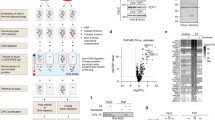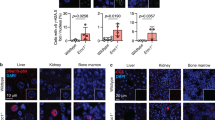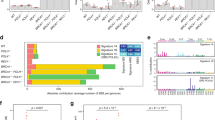Abstract
The Cockayne syndrome B protein (CSB) has long been known to be involved in the repair of DNA modifications that block the RNA polymerase in transcribed DNA sequences (transcription-coupled repair). Recent evidence suggests that it also has a more general role in the repair of oxidative DNA base modifications such as 7,8-dihydro-8-oxo-2′-deoxyguanosine (8-oxoG). In mammalian cells, 8-oxoG is a substrate of the repair glycosylase OGG1. Mice without this enzyme accumulate 8-oxoG in the genome and have elevated spontaneous mutation rates. To elucidate the role of CSB in the prevention of mutations by oxidative DNA base damage, we have generated mice that are deficient in Csb or Ogg1 or both genes and carry a non-transcribed bacterial lacI gene for mutation analysis (Big Blue mice). Our results indicate that the overall spontaneous mutation frequencies in the livers of Csbm/m/Ogg1−/−-mice are elevated not only compared with heterozygous control mice (factor 3.3), but also with Ogg1−/−-animals (factor 1.6). Sequence analysis revealed that the additional mutations caused by CSB deficiency in an Ogg1−/− background are mostly G:C to T:A transversions and small deletions. For all mouse strains, the background levels of oxidative purine modifications in the livers correlate linearly with the numbers of G:C to T:A transversions observed. The data indicate that CSB is involved in the inhibition of mutations caused by spontaneous oxidative DNA base damage in a non-transcribed gene.
This is a preview of subscription content, access via your institution
Access options
Subscribe to this journal
Receive 50 print issues and online access
$259.00 per year
only $5.18 per issue
Buy this article
- Purchase on Springer Link
- Instant access to full article PDF
Prices may be subject to local taxes which are calculated during checkout

Similar content being viewed by others
References
Bjelland S, Seeberg E . (2003). Mutagenicity, toxicity and repair of DNA base damage induced by oxidation. Mutat Res 531: 37–80.
Bruner SD, Norman DP, Verdine GL . (2000). Structural basis for recognition and repair of the endogenous mutagen 8-oxoguanine in DNA. Nature 403: 859–866.
Cheng KC, Cahill DS, Kasai H, Nishimura S, Loeb LA . (1992). 8-Hydroxyguanine, an abundant form of oxidative DNA damage, causes G → T and A → C substitutions. J Biol Chem 267: 166–172.
Dolle ME, Busuttil RA, Garcia AM, Wijnhoven S, van Drunen E, Niedernhofer LJ et al. (2006). Increased genomic instability is not a prerequisite for shortened lifespan in DNA repair deficient mice. Mutat Res 596: 22–35.
ESCODD (2002). Comparative analysis of baseline 8-oxo-7,8-dihydroguanine in mammalian cell DNA, by different methods in different laboratories: an approach to consensus. Carcinogenesis 23: 2129–2133.
ESCODD (2003). Measurement of DNA oxidation in human cells by chromatographic and enzymic methods. Free Radical Biol Med 34: 1089–1099.
Flohr C, Burkle A, Radicella JP, Epe B . (2003). Poly(ADP-ribosyl)ation accelerates DNA repair in a pathway dependent on Cockayne syndrome B protein. Nucleic Acids Res 31: 5332–5337.
Halangoda A, Still JG, Hill KA, Sommer SS . (2001). Spontaneous microdeletions and microinsertions in a transgenic mouse mutation detection system: analysis of age, tissue, and sequence specificity. Environ Mol Mutagen 37: 311–323.
Heinmoller PW, Hill KA, Sommer SS . (2000). High plating density improves Big Blue system efficiency without loss of sensitivity. Mutat Res 453: 97–103.
Helbock HJ, Beckman KB, Shigenaga MK, Walter PB, Woodall AA, Yeo HC et al. (1998). DNA oxidation matters: the HPLC-electrochemical detection assay of 8-oxo-deoxyguanosine and 8-oxo-guanine. Proc Natl Acad Sci USA 95: 288–293.
Hill KA, Buettner VL, Halangoda A, Kunishige M, Moore SR, Longmate J et al. (2004). Spontaneous mutation in Big Blue mice from fetus to old age: tissue-specific time courses of mutation frequency but similar mutation types. Environ Mol Mutagen 43: 110–120.
Hollstein M, Sidransky D, Vogelstein B, Harris CC . (1991). p53 mutations in human cancers. Science 253: 49–53.
Klungland A, Rosewell I, Hollenbach S, Larsen E, Daly G, Epe B et al. (1999). Accumulation of premutagenic DNA lesions in mice defective in removal of oxidative base damage. Proc Natl Acad Sci USA 96: 13300–13305.
Kohler SW, Provost GS, Fieck A, Kretz PL, Bullock WO, Putman DL et al. (1991). Analysis of spontaneous and induced mutations in transgenic mice using a lambda ZAP/lacI shuttle vector. Environ Mol Mutagen 18: 316–321.
Licht CL, Stevnsner T, Bohr VA . (2003). Cockayne syndrome group B cellular and biochemical functions. Am J Hum Genet 73: 1217–1239.
Marnett LJ . (2000). Oxyradicals and DNA damage. Carcinogenesis 21: 361–370.
Mellon I, Bohr VA, Smith CA, Hanawalt PC . (1986). Preferential DNA repair of an active gene in human cells. Proc Natl Acad Sci USA 83: 8878–8882.
Minowa O, Arai T, Hirano M, Monden Y, Nakai S, Fukuda M et al. (2000). Mmh/Ogg1 gene inactivation results in accumulation of 8-hydroxyguanine in mice. Proc Natl Acad Sci USA 97: 4156–4161.
Moriya M . (1993). Single-stranded shuttle phagemid for mutagenesis studies in mammalian cells: 8-oxoguanine in DNA induces targeted G.C → T.A transversions in simian kidney cells. Proc Natl Acad Sci USA 90: 1122–1126.
Nishino H, Buettner VL, Sommer SS . (1996). Towards validation of the Big Blue transgenic mouse mutagenesis assay: the mutational spectrum of ex vivo pinpoint mutant plaques. Mutat Res 372: 97–105.
Osterod M, Hollenbach S, Hengstler JG, Barnes DE, Lindahl T, Epe B . (2001). Age-related and tissue-specific accumulation of oxidative DNA base damage in 7,8-dihydro-8-oxoguanine-DNA glycosylase (Ogg1) deficient mice. Carcinogenesis 22: 1459–1463.
Osterod M, Larsen E, Le Page F, Hengstler JG, Van der Horst GT, Boiteux S et al. (2002). A global DNA repair mechanism involving the Cockayne syndrome B (CSB) gene product can prevent the in vivo accumulation of endogenous oxidative DNA base damage. Oncogene 21: 8232–8239.
Pflaum M, Will O, Epe B . (1997). Determination of steady-state levels of oxidative DNA base modifications in mammalian cells by means of repair endonucleases. Carcinogenesis 18: 2225–2231.
Provost GS, Short JM . (1994). Characterization of mutations induced by ethylnitrosourea in seminiferous tubule germ cells of transgenic B6C3F1 mice. Proc Natl Acad Sci USA 91: 6564–6568.
Radicella JP, Dherin C, Desmaze C, Fox MS, Boiteux S . (1997). Cloning and characterization of hOGG1, a human homolog of the OGG1 gene of Saccharomyces cerevisiae. Proc Natl Acad Sci USA 94: 8010–8015.
Shibutani S, Takeshita M, Grollman AP . (1991). Insertion of specific bases during DNA synthesis past the oxidation-damaged base 8-oxodG. Nature 349: 431–434.
Svejstrup JQ . (2002). Mechanisms of transcription-coupled DNA repair. Nat Rev Mol Cell Biol 3: 21–29.
Van der Horst GT, van Steeg H, Berg RJ, van Gool AJ, de Wit J, Weeda G et al. (1997). Defective transcription-coupled repair in Cockayne syndrome B mice is associated with skin cancer predisposition. Cell 89: 425–435.
van Hoffen A, Natarajan AT, Mayne LV, van Zeeland AA, Mullenders LH, Venema J . (1993). Deficient repair of the transcribed strand of active genes in Cockayne's syndrome cells. Nucleic Acids Res 21: 5890–5895.
Xie Y, Yang H, Cunanan C, Okamoto K, Shibata D, Pan J et al. (2004). Deficiencies in mouse Myh and Ogg1 result in tumor predisposition and G to T mutations in codon 12 of the K-ras oncogene in lung tumors. Cancer Res 64: 3096–3102.
Young RR, Rogers BJ, Provost GS, Short JM, Putman DL . (1995). Interlaboratory comparison: liver spontaneous mutant frequency from lambda/lacI transgenic mice (Big Blue) (II). Mutat Res 327: 67–73.
Acknowledgements
This work was supported by the Deutsche Forschungsgemeinschaft (Ep11/5) and the DAAD. We are grateful to Lydia Weidenfeller and Karin Pauly for excellent technical help and animal care.
Author information
Authors and Affiliations
Corresponding author
Additional information
Supplementary Information accompanies the paper on the Oncogene website (http://www.nature.com/onc).
Supplementary information
Rights and permissions
About this article
Cite this article
Trapp, C., Reite, K., Klungland, A. et al. Deficiency of the Cockayne syndrome B (CSB) gene aggravates the genomic instability caused by endogenous oxidative DNA base damage in mice. Oncogene 26, 4044–4048 (2007). https://doi.org/10.1038/sj.onc.1210167
Received:
Revised:
Accepted:
Published:
Issue Date:
DOI: https://doi.org/10.1038/sj.onc.1210167
Keywords
This article is cited by
-
Crosstalk between MSH2–MSH3 and polβ promotes trinucleotide repeat expansion during base excision repair
Nature Communications (2016)
-
Progeroid Syndromes and UV-Induced Oxidative DNA Damage
Journal of Investigative Dermatology Symposium Proceedings (2009)



